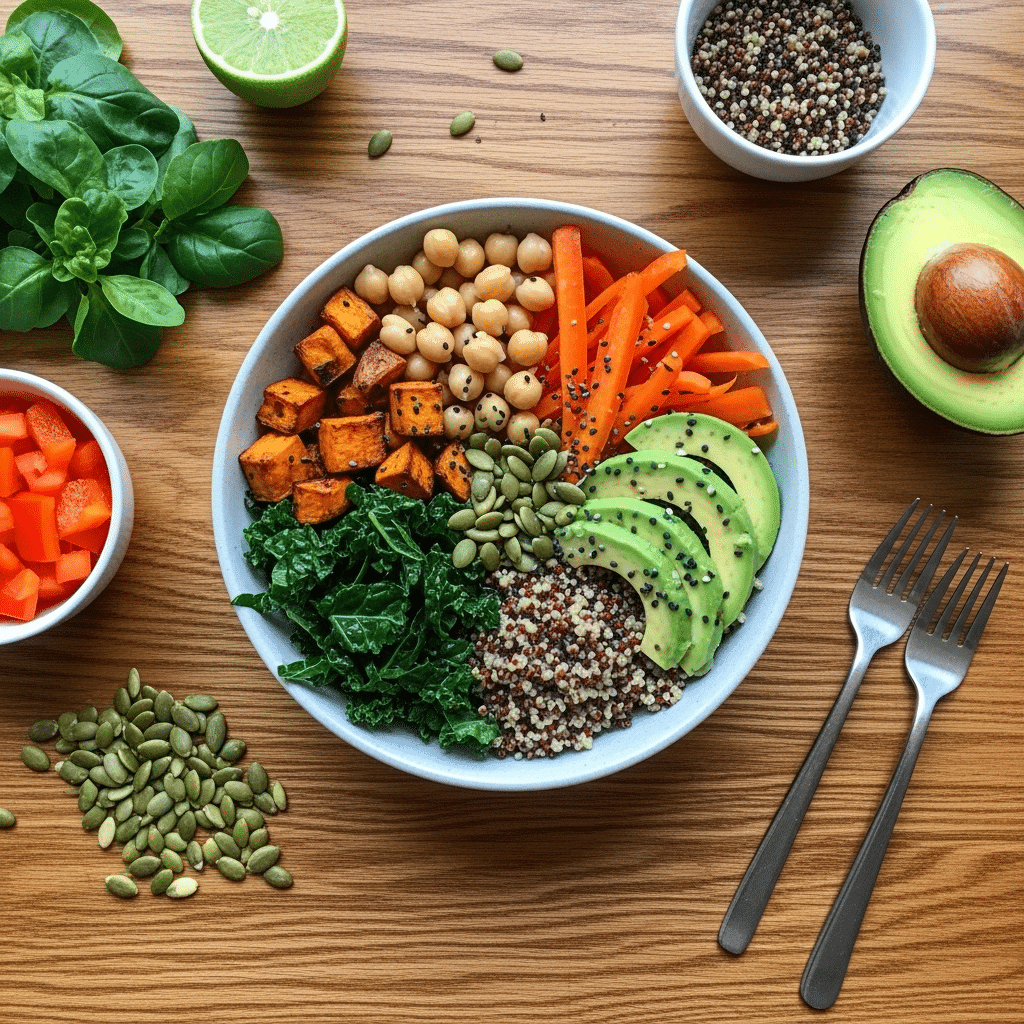I found out about Fiber-Rich Buddha Bowls and they changed my eating habits. These colorful meals are not just a trend. They are full of nutrients and taste great.
Buddha bowls are a form of cooking art. They turn simple foods into a tasty and healthy meal. With a mix of veggies, grains, and proteins, they give you a meal that’s good for you and delicious.
The best thing about Fiber-Rich Buddha Bowls is how flexible they are. They’re perfect for anyone wanting to eat healthier. These bowls make it easy to get more fiber and look good while doing it.
Key Takeaways
- Buddha bowls offer a complete nutritional profile in one dish
- Fiber-rich ingredients support digestive health
- Meals can be customized to individual dietary preferences
- Plant-based ingredients promote overall wellness
- Buddha bowls are visually appealing and satisfying
What are Buddha Bowls?
Buddha bowls are a hit for those who love nutritious meals that taste great and are easy to make. These vibrant bowls are more than just food; they’re a way to eat mindfully and healthily.
The idea of Buddha bowls started as a way to mix lots of nutrients into one dish. They might be named after the Buddhist tradition of collecting alms in a bowl. These meals support a diet rich in fiber and promote mindful eating.
Origins and Cultural Significance
Buddha bowls are about finding balance and nourishment in every meal. Inspired by mindful eating, they mix ingredients in a way that gives you everything you need for a healthy meal.
- Rooted in plant-based culinary traditions
- Symbolizes wholeness and intentional eating
- Represents a holistic approach to nutrition
Key Ingredients in Buddha Bowls
A Buddha bowl has several key parts to make a balanced meal:
| Category | Examples | Nutritional Benefit |
|---|---|---|
| Grains | Quinoa, Brown Rice | Complex carbohydrates |
| Proteins | Chickpeas, Tofu | Plant-based protein |
| Vegetables | Kale, Roasted Sweet Potatoes | Vitamins and minerals |
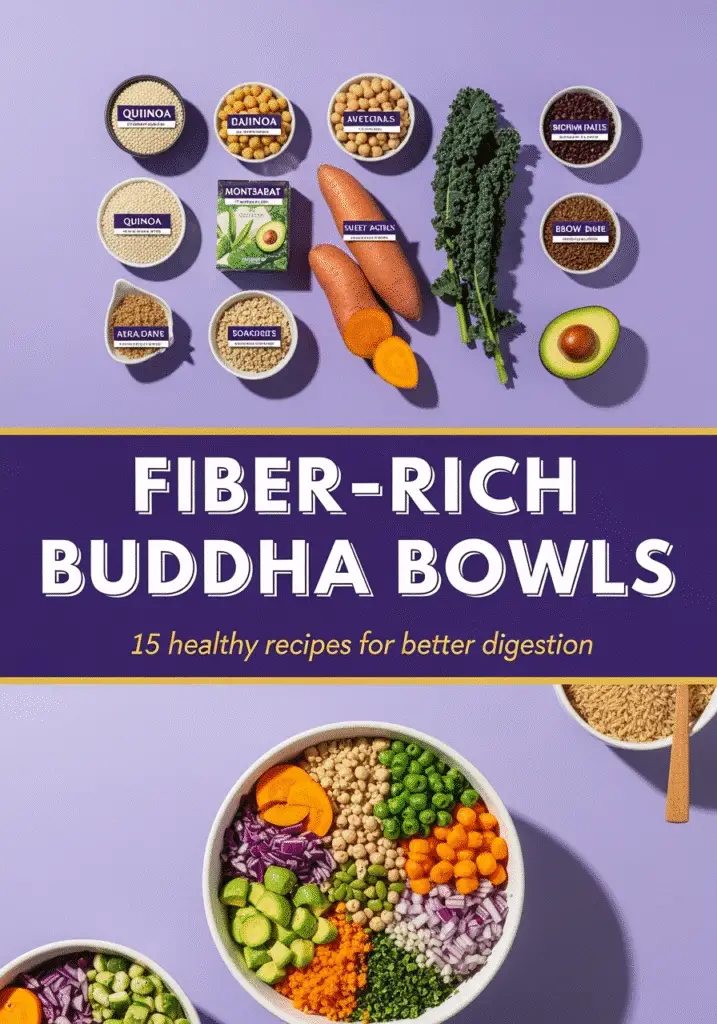
The Nutritional Benefits of Buddha Bowls
Buddha bowls are super good for you. They combine many food groups in one dish, giving you a wide range of nutrients. These bowls help with digestion, give you energy, and boost your overall health.
Whether you’re into healthy eating or just want to try something new, Buddha bowls are a tasty and nutritious choice. They fit any diet and taste great.
Why Fiber-Rich Foods Matter
Eating foods high in fiber is key for staying healthy. Fiber helps our body work right, making it a must for good eating. Learning about recipes rich in fiber can change how you see food.
Fiber does more than help with digestion. It’s a big player in our health. By adding fiber-rich buddha bowls to your meals, you’re choosing well for your health.
Health Benefits of Dietary Fiber
A diet full of fiber has many benefits. Here are some:
- Supports heart health by lowering cholesterol levels
- Helps manage blood sugar regulation
- Promotes healthy weight management
- Reduces risk of certain chronic diseases
How Fiber Affects Digestion
Digestive health gets a big boost from fiber. It helps food move through your system, prevents constipation, and keeps your gut healthy. Soluble and insoluble fibers work together for better digestion.
Daily Fiber Recommendations
It’s important to get enough fiber every day. Here are the daily amounts you should aim for:
| Age Group | Daily Fiber Recommendation |
|---|---|
| Adult Women (19-50) | 25 grams |
| Adult Men (19-50) | 38 grams |
| Adults Over 50 | 21-30 grams |
Nutritious recipes like buddha bowls can help you meet these fiber goals. By mixing whole grains, legumes, and veggies, you can make tasty meals that are good for you.
Top Ingredients for Fiber-Rich Buddha Bowls
Starting with the right ingredients is key to making tasty plant-based meals. Buddha bowls are perfect for nutritious vegetarian dishes. They offer both flavor and health benefits. Let’s explore the essential parts that make these bowls satisfying and full of nutrients.
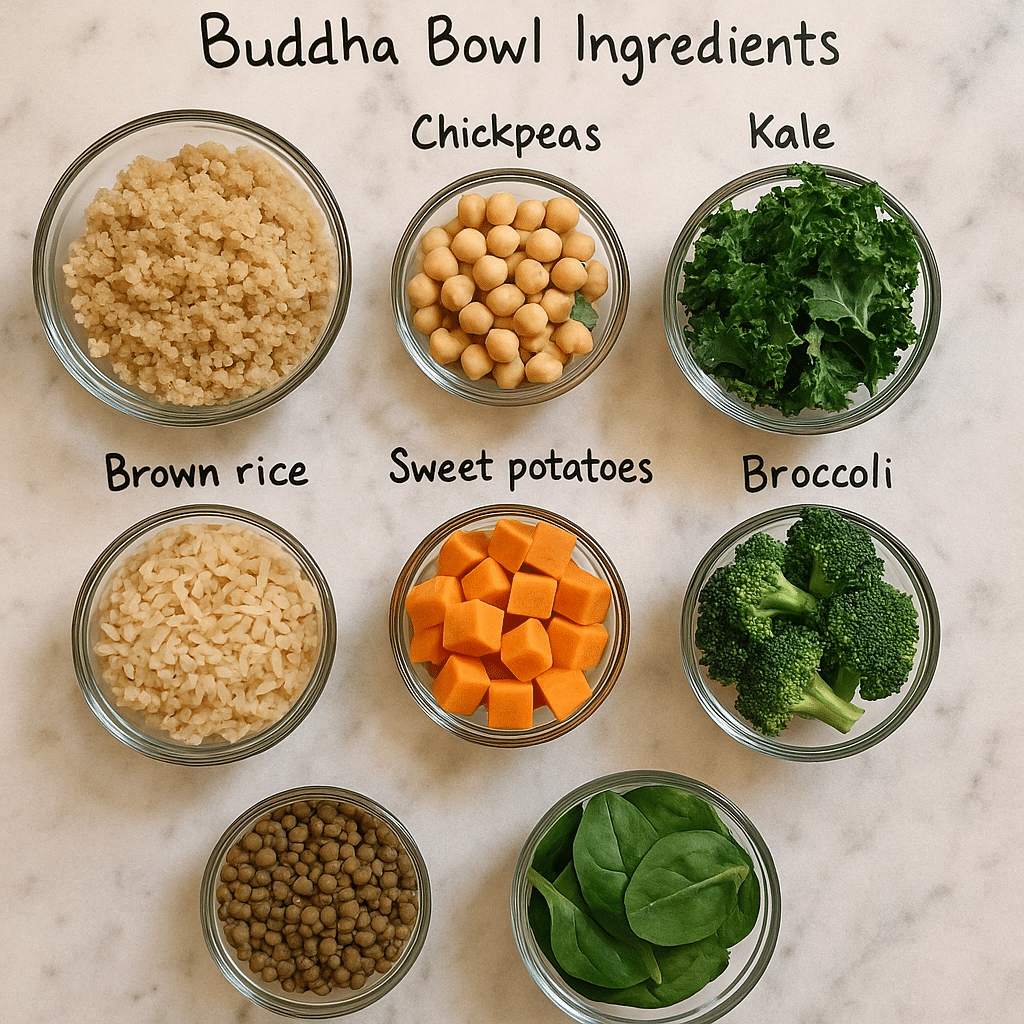
Grains: The Foundation of Your Bowl
Whole grains are the base of any Buddha bowl. Quinoa and brown rice are nutritional powerhouses. They provide fiber and complex carbs. Here are my top grain picks:
- Quinoa (complete protein with 5.2g fiber per cup)
- Brown rice (3.5g fiber per cup)
- Farro (7.6g fiber per cup)
- Barley (6g fiber per cup)
Legumes: Protein-Packed Fiber Boosters
Legumes are key for filling vegetarian dishes. They offer plant-based protein and fiber.
| Legume | Fiber (per cup) | Protein (per cup) |
|---|---|---|
| Chickpeas | 12.5g | 14.5g |
| Black Beans | 15g | 15.2g |
| Lentils | 15.6g | 17.9g |
Vegetables: Nutrition and Color
No Buddha bowl is complete without colorful veggies. I suggest adding leafy greens and cruciferous veggies for nutrition:
- Kale (2.6g fiber per cup)
- Broccoli (5.1g fiber per cup)
- Spinach (4.3g fiber per cup)
- Roasted sweet potatoes
By mixing these ingredients, you’ll get a meal that’s tasty and healthy. Each part adds unique textures, flavors, and health benefits to your bowl.
Building a Balanced Buddha Bowl
Making a perfect Buddha bowl is like creating a work of art. It’s all about balanced nutrition and tasty flavors. These meals are not only healthy but also look great and taste amazing.
Portioning Your Ingredients
Think of your Buddha bowl as a canvas for nutrition. A good bowl should have a mix of ingredients. Here’s a guide to help you:
- 25% whole grains (quinoa, brown rice)
- 35% colorful vegetables
- 15% lean protein
- 10% flavorful sauce
- 10% crunchy toppings
Flavor Enhancers: Dressings and Sauces
Sauces can turn a simple bowl into a feast. Here are some top picks:
- Tahini-based dressing with lemon and garlic
- Spicy peanut sauce
- Miso-ginger vinaigrette
Toppings and Crunch: Nuts and Seeds
Adding crunchy toppings is the final step. It brings texture and extra nutrition. Try roasted seeds or chopped nuts. They add a nice crunch and boost nutrition.
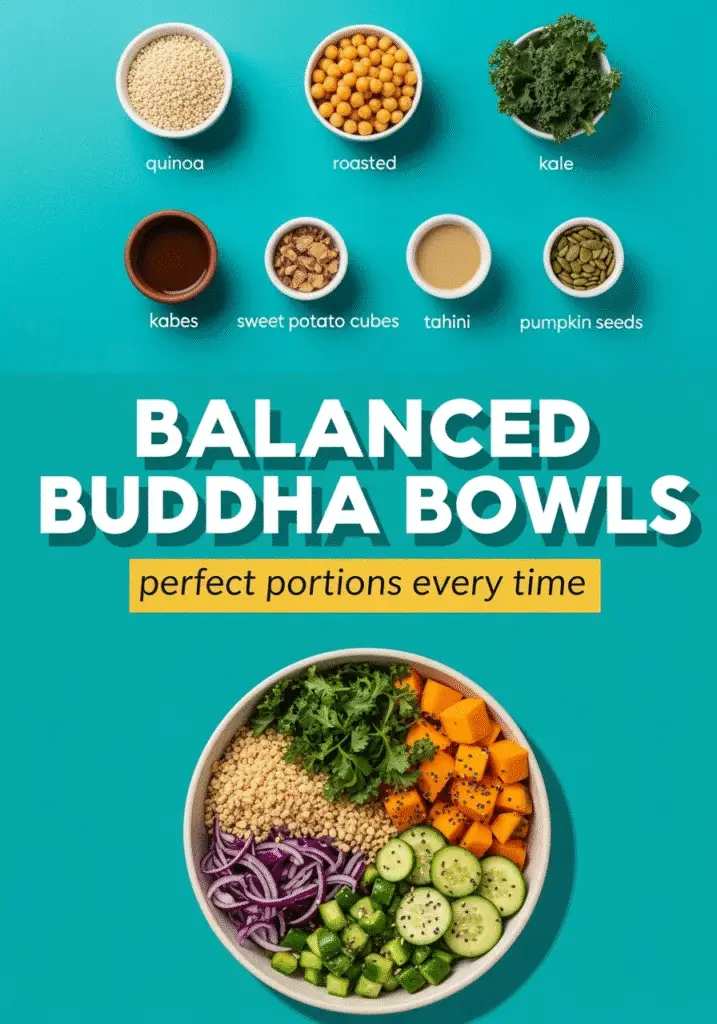
Creative Buddha Bowl Combinations
Buddha bowls are a blank canvas for creativity, turning vegetarian dishes into colorful, healthy meals. They let you mix and match flavors and ingredients, making your plant-based meals exciting and tasty.
Seasonal Vegetable Bowls
Using seasonal produce in Buddha bowls boosts flavor and nutrition. I love picking fresh, local veggies that match each season:
- Spring: Asparagus, peas, and tender greens
- Summer: Colorful heirloom tomatoes, zucchini, and corn
- Fall: Roasted butternut squash, Brussels sprouts, and kale
- Winter: Roasted root vegetables and hearty winter greens
Global Influences: Mediterranean and Asian Flavors
Exploring international cuisines turns simple Buddha bowls into exciting dishes. Mediterranean-inspired bowls might include:
- Falafel
- Hummus
- Kalamata olives
- Tzatziki sauce
Asian-inspired options might have:
- Edamame
- Crispy tofu
- Miso dressing
- Pickled vegetables
Protein-Packed Options for Satiety
Creating satisfying vegetarian dishes means adding the right proteins. Legumes, tofu, tempeh, and quinoa are great choices. They keep your grain bowls full and nutritious.
Trying out different mixes shows that Buddha bowls are more than food. They’re a way to express creativity, health, and global tastes.
Meal Prep Tips for Buddha Bowls
Making tasty and healthy Buddha bowls doesn’t take long. With some smart meal prep, you can enjoy nutritious meals all week. These bowls are great for those on a high-fiber diet who want easy, healthy meals.
Batch Cooking Base Ingredients
It’s important to prep your base ingredients ahead of time. Spend a few hours each week on batch cooking:
- Cook big batches of quinoa, brown rice, or other whole grains
- Roast different veggies in one pan
- Prepare beans or lentils as protein
- Wash and chop fresh greens
Smart Storage Solutions
Storing your ingredients right keeps them fresh. Use clear, airtight containers for each part. Most prepped foods stay good in the fridge for 3-5 days. This lets you mix and match all week.
Customizing for Different Diets
Buddha bowls fit many diets. You can make them vegan, gluten-free, or for any specific diet:
- Try cauliflower rice for low-carb options
- Swap grains for spiralized veggies
- Add plant-based or animal proteins as needed
- Adjust dressings to fit dietary needs
With these meal prep tips, healthy eating becomes simple and enjoyable. Your Buddha bowls will be a tasty, nutritious choice for busy times.
Family-Friendly Buddha Bowls
It can be tough for parents to find healthy meals that kids enjoy. Buddha bowls are a great way to make mealtime fun and teach kids about different vegetarian dishes.
To make healthy recipes appealing to kids, you need to be creative. Letting them help in the kitchen can make them excited about eating nutritious foods.
Kid-Approved Ingredients
Choose colorful and fun ingredients for kids’ Buddha bowls. Here are some great options:
- Colorful roasted sweet potato cubes
- Mild-flavored quinoa or brown rice
- Crispy baked tofu strips
- Crunchy cucumber rounds
- Mild-flavored beans
Encouraging Healthy Eating Habits
Buddha bowls are a great way to introduce kids to new foods. The bright colors make these meals more appealing. This helps kids like vegetables and whole grains more.
Involving Kids in Bowl Creation
Let kids be your kitchen helpers. Let them pick ingredients, mix, and make their own bowls. This turns healthy eating into a fun adventure.
- Create a “build-your-own” Buddha bowl station
- Use small cookie cutters to shape vegetables
- Let kids select their favorite sauces
- Encourage creativity with ingredient placement
Pro tip: Make mealtime fun by giving each Buddha bowl a playful name that children can help create!
Popular Recipes for Fiber-Rich Buddha Bowls
Exploring Fiber-Rich Buddha Bowls can change how you enjoy plant-based meals. These dishes are not only healthy but also taste great. They make eating well easy and fun.
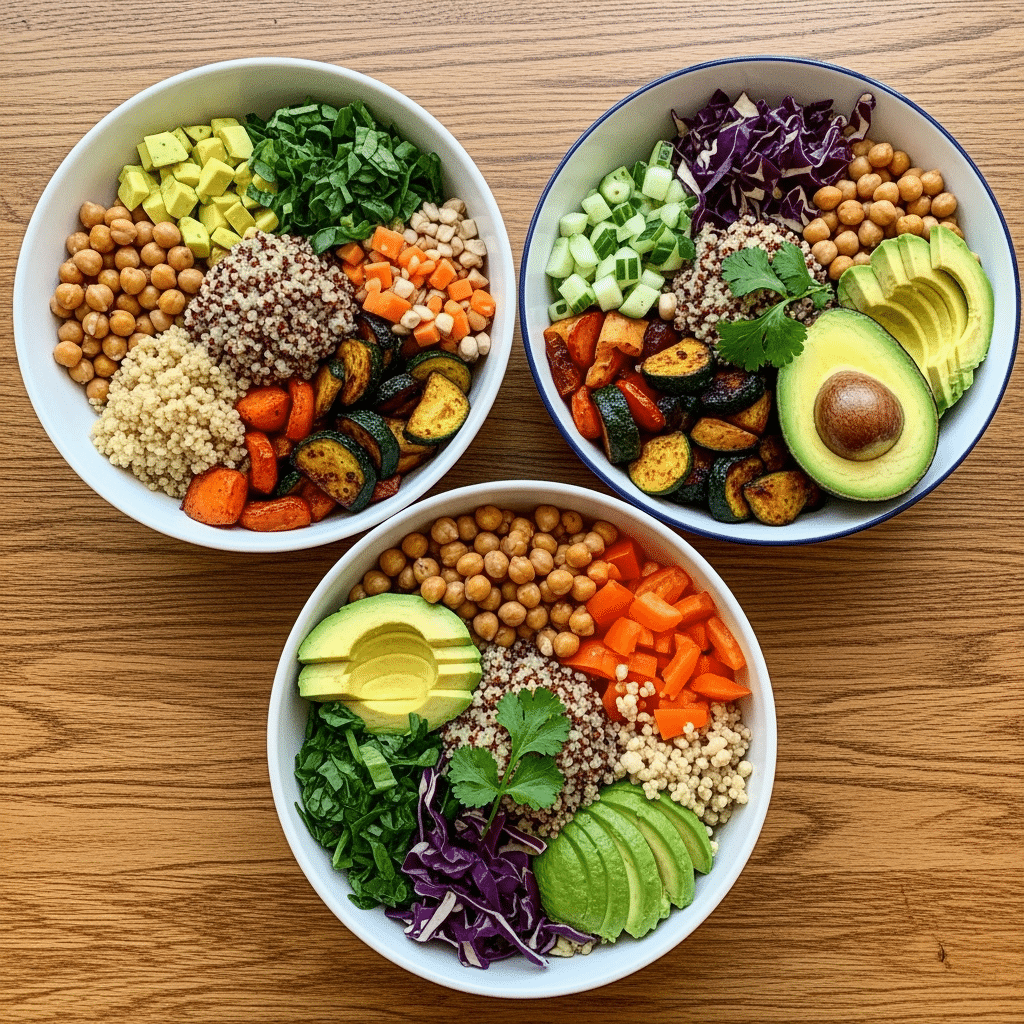
Classic Quinoa Buddha Bowl
I enjoy making a simple yet nutritious quinoa Buddha bowl. It’s packed with fiber. Here’s what you need:
- 1 cup cooked quinoa
- 1/2 cup roasted chickpeas
- 1 cup mixed roasted vegetables
- 1/4 avocado, sliced
- 2 tablespoons tahini dressing
To make it, just layer the ingredients in a bowl. Then, drizzle with tahini dressing. The quinoa is protein-rich, and the veggies add important nutrients.
Spicy Chickpea and Sweet Potato Bowl
If you like bold flavors, try this spicy Buddha bowl. It’s a real treat:
- 1 cup roasted sweet potato cubes
- 1/2 cup spiced chickpeas
- 1/4 cup kale
- 2 tablespoons sriracha sauce
- Sprinkle of pumpkin seeds
Thai Peanut Tofu Bowl
This dish brings a taste of the world to your Buddha bowl. It’s full of flavor:
- 1 cup baked tofu
- 1/2 cup brown rice
- 1/4 cup edamame
- 2 tablespoons Thai peanut sauce
- Fresh cilantro garnish
Each recipe is a unique way to make a delicious, healthy Buddha bowl. They’re perfect for a balanced diet.
| Recipe | Fiber Content | Preparation Time |
|---|---|---|
| Quinoa Buddha Bowl | 12g | 15 minutes |
| Spicy Chickpea Bowl | 15g | 20 minutes |
| Thai Peanut Tofu Bowl | 14g | 25 minutes |
Where to Enjoy Buddha Bowls
Exploring superfood bowls beyond your kitchen is exciting. Health-conscious restaurants across the United States now offer these meals. This makes it easy to enjoy antioxidant-rich meals without the hassle of cooking.
Visiting local farmers markets is a great way to find ingredients. These markets are full of fresh, seasonal produce perfect for Buddha bowls. California markets like San Francisco’s Ferry Building and Los Angeles’ Hollywood Farmers Market offer amazing organic vegetables and grains.
Digital resources have changed how we find and make Buddha bowls. Websites like Minimalist Baker, Love and Lemons, and Pinterest have lots of recipes and ideas. Instagram accounts focused on plant-based cooking show off creative bowl designs, inspiring you to make amazing meals.
If you prefer eating out, chains like Sweetgreen and True Food Kitchen have Buddha bowl options. They know people want healthy, customizable meals that support wellness and taste great.
FAQ
What exactly is a Buddha bowl?
A Buddha bowl is a nutritious meal in one bowl. It has whole grains, legumes, veggies, and proteins. It’s called a Buddha bowl because it looks like a Buddha’s belly.
How much fiber should I aim to consume daily?
Adults should aim for 25-30 grams of fiber daily. Buddha bowls can help with this by using foods like quinoa, beans, and greens.
Are Buddha bowls suitable for special diets?
Yes, they are! Buddha bowls can fit many diets like vegetarian, vegan, and gluten-free. Just swap or leave out certain ingredients.
Can I prepare Buddha bowls in advance?
Yes, they’re great for meal prep. Cook grains, roast veggies, and prep proteins ahead. Store them separately and assemble your bowl when you’re ready.
How can I make Buddha bowls more interesting for kids?
Get kids involved in making them. Use colorful ingredients and let them pick toppings. It makes eating healthy fun for them.
What are some good protein sources for Buddha bowls?
Good proteins include tofu, tempeh, chickpeas, lentils, and grilled chicken. Hard-boiled eggs and beans are also great. They add protein and fiber.
Are Buddha bowls expensive to make?
No, they’re not! Use affordable ingredients like beans, veggies, and grains. Buying in bulk and choosing local produce can save money.
How long can I store Buddha bowl ingredients?
Cooked grains last 3-5 days in the fridge. Roasted veggies can last 4-5 days. Keep them in sealed containers and check freshness before eating.
Can Buddha bowls help with weight management?
Yes, they can! Their high fiber content helps you feel full. Plus, they offer balanced nutrients for energy.
Are there global variations of Buddha bowls?
Yes! Buddha bowls are inspired by cuisines like Mediterranean, Asian, and Latin American. Each offers unique flavors and ingredients.

Fiber-Rich Buddha Bowls: 15 Nutritious Recipes for Better Digestive Health
- Total Time: 40
- Yield: 2 1x
- Diet: Vegetarian
Description
A nutritious and fiber-rich Buddha bowl packed with quinoa, roasted chickpeas, and colorful vegetables. This complete meal provides over 12g of fiber and delivers essential nutrients for optimal digestive health and sustained energy.
Ingredients
1 cup cooked quinoa
1/2 cup roasted chickpeas
1/2 cup roasted sweet potato cubes
1 cup fresh kale, massaged
1/4 avocado, sliced
2 tablespoons tahini dressing
1 tablespoon pumpkin seeds
1/4 cup shredded purple cabbage
1/4 cup diced cucumber
1 tablespoon hemp hearts
Salt and pepper to taste
Instructions
1. Cook quinoa according to package directions and let cool
2. Preheat oven to 400°F and line baking sheet with parchment
3. Toss chickpeas and sweet potato cubes with olive oil, salt, and pepper
4. Roast for 20-25 minutes until golden and tender
5. Massage kale leaves with a pinch of salt and lemon juice
6. Prepare tahini dressing by whisking tahini, lemon juice, water, and maple syrup
7. Arrange quinoa as base in bowl
8. Add roasted chickpeas and sweet potatoes in sections
9. Place massaged kale and fresh vegetables around bowl
10. Top with sliced avocado and sprinkle with seeds
11. Drizzle with tahini dressing and serve immediately
Notes
Store components separately for meal prep – keeps fresh for 3-4 days
Substitute any vegetables based on seasonal availability
Add protein like tempeh or tofu for extra satisfaction
Dressing can be made 1 week in advance and stored in refrigerator
For extra fiber, add 1 tablespoon ground flaxseed
- Prep Time: 15
- Cook Time: 25
- Category: Main Dish
- Method: Roasting
- Cuisine: Plant-Based
Nutrition
- Serving Size: 1
- Calories: 485
- Sugar: 8g
- Sodium: 320mg
- Fat: 18g
- Saturated Fat: 3g
- Unsaturated Fat: 15g
- Trans Fat: 0g
- Carbohydrates: 68g
- Fiber: 14g
- Protein: 18g
- Cholesterol: 0mg

